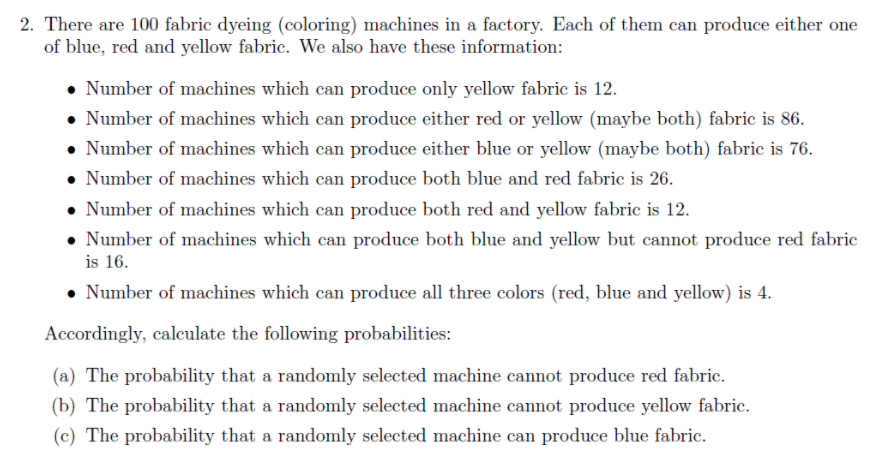2. There are 100 fabric dyeing (coloring) machines in a factory. Each of them can produce either one of blue, red and yellow fabric. We also have these information: Number of machines which can produce only yellow fabric is 12. • Number of machines which can produce either red or yellow (maybe both) fabric is 86. • Number of machines which can produce either blue or yellow (maybe both) fabric is 76. • Number of machines which can produce both blue and red fabric is 26. • Number of machines which can produce both red and yellow fabric is 12. • Number of machines which can produce both blue and yellow but cannot produce red fabric is 16. • Number of machines which can produce all three colors (red, blue and yellow) is 4. Accordingly, calculate the following probabilities: (a) The probability that a randomly selected machine cannot produce red fabric. (b) The probability that a randomly selected machine cannot produce yellow fabric. (c) The probability that a randomly selected machine can produce blue fabric.
2. There are 100 fabric dyeing (coloring) machines in a factory. Each of them can produce either one of blue, red and yellow fabric. We also have these information: Number of machines which can produce only yellow fabric is 12. • Number of machines which can produce either red or yellow (maybe both) fabric is 86. • Number of machines which can produce either blue or yellow (maybe both) fabric is 76. • Number of machines which can produce both blue and red fabric is 26. • Number of machines which can produce both red and yellow fabric is 12. • Number of machines which can produce both blue and yellow but cannot produce red fabric is 16. • Number of machines which can produce all three colors (red, blue and yellow) is 4. Accordingly, calculate the following probabilities: (a) The probability that a randomly selected machine cannot produce red fabric. (b) The probability that a randomly selected machine cannot produce yellow fabric. (c) The probability that a randomly selected machine can produce blue fabric.
College Algebra
7th Edition
ISBN:9781305115545
Author:James Stewart, Lothar Redlin, Saleem Watson
Publisher:James Stewart, Lothar Redlin, Saleem Watson
Chapter9: Counting And Probability
Section: Chapter Questions
Problem 2T: A hospital cafeteria offers a fixed-price lunch consisting of a main course, a dessert and a drink....
Related questions
Concept explainers
Contingency Table
A contingency table can be defined as the visual representation of the relationship between two or more categorical variables that can be evaluated and registered. It is a categorical version of the scatterplot, which is used to investigate the linear relationship between two variables. A contingency table is indeed a type of frequency distribution table that displays two variables at the same time.
Binomial Distribution
Binomial is an algebraic expression of the sum or the difference of two terms. Before knowing about binomial distribution, we must know about the binomial theorem.
Topic Video
Question
6.2

Transcribed Image Text:2. There are 100 fabric dyeing (coloring) machines in a factory. Each of them can produce either one
of blue, red and yellow fabric. We also have these information:
• Number of machines which can produce only yellow fabric is 12.
• Number of machines which can produce either red or yellow (maybe both) fabric is 86.
• Number of machines which can produce either blue or yellow (maybe both) fabric is 76.
• Number of machines which can produce both blue and red fabric is 26.
• Number of machines which can produce both red and yellow fabric is 12.
• Number of machines which can produce both blue and yellow but cannot produce red fabric
is 16.
• Number of machines which can produce all three colors (red, blue and yellow) is 4.
Accordingly, calculate the following probabilities:
(a) The probability that a randomly selected machine cannot produce red fabric.
(b) The probability that a randomly selected machine cannot produce yellow fabric.
(c) The probability that a randomly selected machine can produce blue fabric.
Expert Solution
This question has been solved!
Explore an expertly crafted, step-by-step solution for a thorough understanding of key concepts.
Step by step
Solved in 4 steps with 3 images

Knowledge Booster
Learn more about
Need a deep-dive on the concept behind this application? Look no further. Learn more about this topic, probability and related others by exploring similar questions and additional content below.Recommended textbooks for you

College Algebra
Algebra
ISBN:
9781305115545
Author:
James Stewart, Lothar Redlin, Saleem Watson
Publisher:
Cengage Learning

Algebra and Trigonometry (MindTap Course List)
Algebra
ISBN:
9781305071742
Author:
James Stewart, Lothar Redlin, Saleem Watson
Publisher:
Cengage Learning

Algebra & Trigonometry with Analytic Geometry
Algebra
ISBN:
9781133382119
Author:
Swokowski
Publisher:
Cengage

College Algebra
Algebra
ISBN:
9781305115545
Author:
James Stewart, Lothar Redlin, Saleem Watson
Publisher:
Cengage Learning

Algebra and Trigonometry (MindTap Course List)
Algebra
ISBN:
9781305071742
Author:
James Stewart, Lothar Redlin, Saleem Watson
Publisher:
Cengage Learning

Algebra & Trigonometry with Analytic Geometry
Algebra
ISBN:
9781133382119
Author:
Swokowski
Publisher:
Cengage
